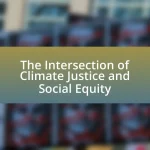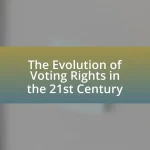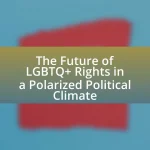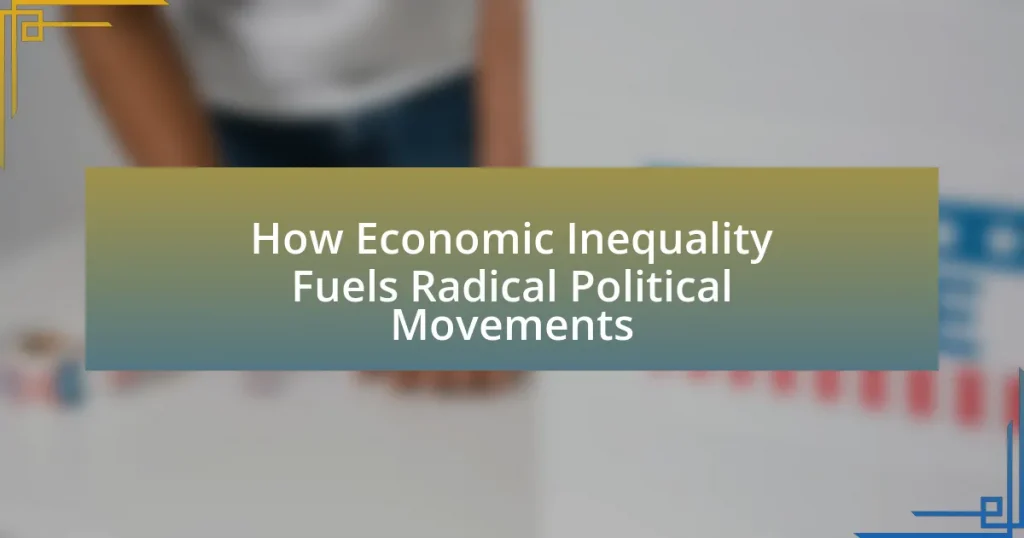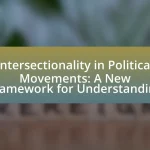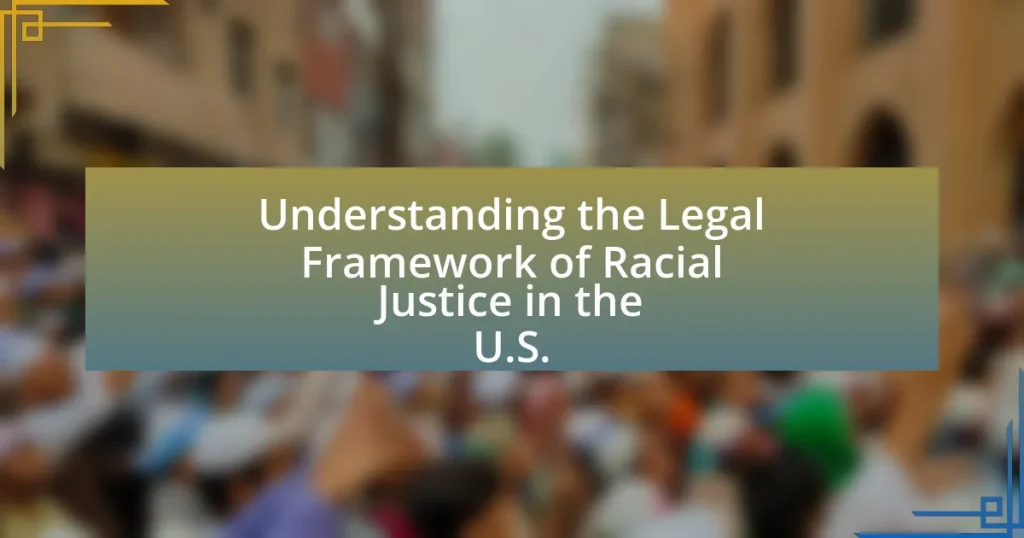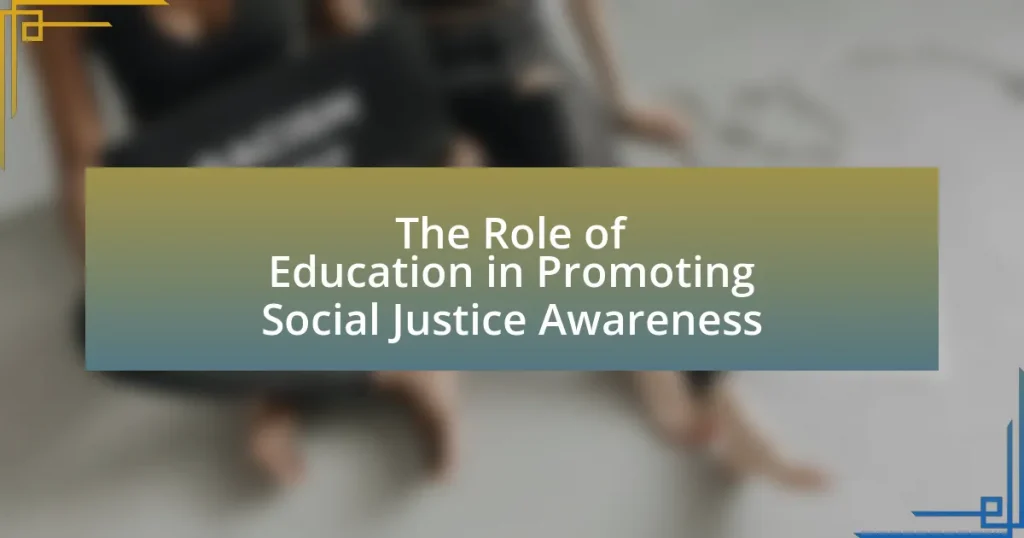Economic inequality serves as a significant driver of radical political movements, as disparities in wealth and opportunity often lead to social unrest and demands for systemic change. Historical examples, such as the Great Depression and the 2008 financial crisis, illustrate how economic disparities can catalyze the rise of radical ideologies, including socialism and populism. The article explores the psychological effects of economic disparity on individuals, the influence of perceived injustice on radicalization, and the role of technology and social media in mobilizing support for these movements. Additionally, it discusses effective community initiatives and policies aimed at addressing economic inequality and mitigating its political consequences.
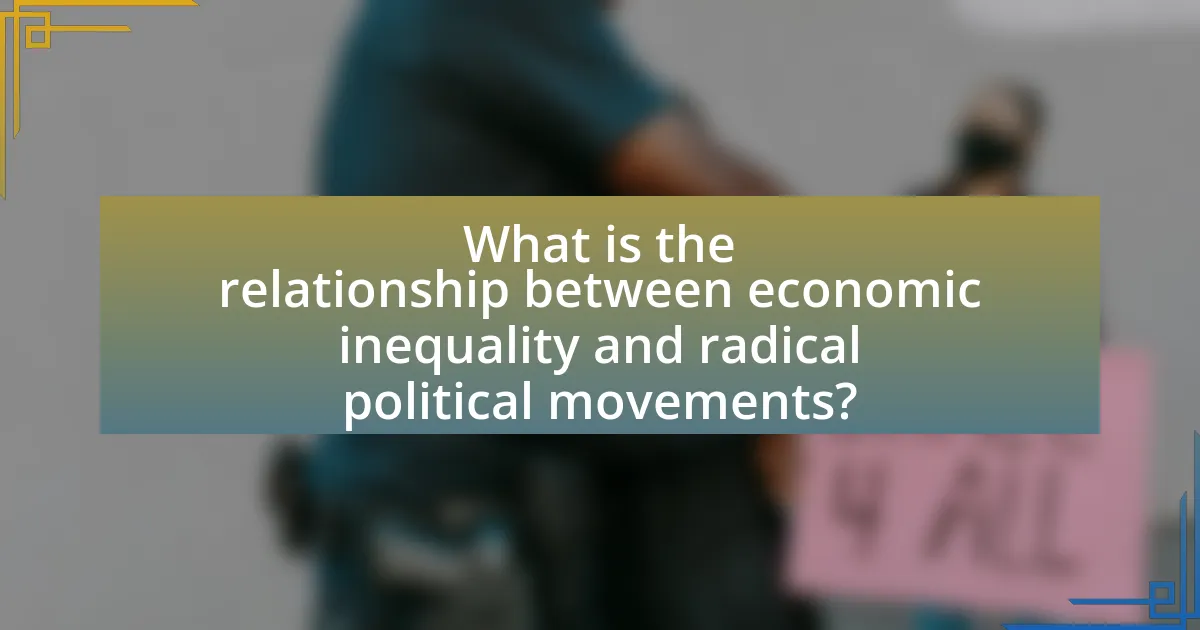
What is the relationship between economic inequality and radical political movements?
Economic inequality often serves as a catalyst for radical political movements, as disparities in wealth and opportunity can lead to social unrest and demands for systemic change. Historical evidence shows that periods of significant economic inequality, such as the Great Depression or the 2008 financial crisis, have been associated with the rise of radical ideologies and movements, including socialism and populism. For instance, the Occupy Wall Street movement emerged in response to the growing wealth gap in the United States, highlighting the frustrations of those feeling marginalized by economic policies favoring the wealthy. Studies indicate that when a significant portion of the population perceives economic injustice, it can lead to increased support for radical political solutions aimed at addressing these inequalities.
How does economic inequality contribute to social unrest?
Economic inequality contributes to social unrest by creating a significant divide between different socioeconomic groups, leading to feelings of disenfranchisement and frustration among those with fewer resources. When wealth is concentrated in the hands of a small percentage of the population, as evidenced by the 2019 Oxfam report which stated that the world’s 26 richest people own as much wealth as the poorest half of humanity, it fosters resentment and a sense of injustice. This disparity can result in protests, riots, and other forms of civil disobedience as marginalized groups seek to voice their grievances and demand change. Historical examples, such as the Arab Spring, illustrate how economic disparities can trigger widespread social movements aimed at addressing perceived inequalities and injustices.
What are the psychological effects of economic disparity on individuals?
Economic disparity significantly impacts individuals’ psychological well-being, leading to increased stress, anxiety, and feelings of inadequacy. Research indicates that individuals in lower socioeconomic positions often experience chronic stress due to financial instability, which can result in mental health issues such as depression and anxiety disorders. A study published in the American Journal of Public Health found that economic inequality correlates with higher rates of mental health problems, as individuals perceive their social status as lower compared to wealthier peers. Furthermore, feelings of social exclusion and diminished self-esteem are common among those affected by economic disparity, contributing to a sense of hopelessness and frustration. These psychological effects can drive individuals toward radical political movements as they seek to address perceived injustices and advocate for systemic change.
How does economic inequality influence group identity and cohesion?
Economic inequality significantly influences group identity and cohesion by fostering a sense of shared grievance among disadvantaged groups. This shared experience of economic hardship can lead to stronger in-group solidarity as individuals identify more closely with others facing similar struggles. Research indicates that when economic disparities are pronounced, marginalized groups often unite to advocate for their interests, enhancing group cohesion. For instance, studies show that communities experiencing high levels of inequality are more likely to mobilize for collective action, as seen in movements like Occupy Wall Street, which emerged in response to the growing wealth gap. This mobilization is driven by a collective identity that emphasizes common economic challenges, reinforcing group bonds and a unified stance against perceived injustices.
Why do marginalized groups turn to radical political movements?
Marginalized groups turn to radical political movements primarily due to systemic economic inequality and social exclusion. These groups often experience limited access to resources, opportunities, and political representation, leading to feelings of disenfranchisement and frustration. For instance, research by the Pew Research Center indicates that economic disparities can drive individuals to seek alternative political solutions when traditional systems fail to address their needs. This sense of urgency can catalyze a shift towards radical ideologies as a means of advocating for change and asserting their rights.
What role does perceived injustice play in radicalization?
Perceived injustice significantly contributes to radicalization by fostering feelings of disenfranchisement and resentment among individuals or groups. When people perceive that they are treated unfairly or that their rights are being violated, they may become more susceptible to extremist ideologies that promise empowerment or retribution. Research indicates that individuals facing economic inequality often experience a heightened sense of injustice, which can lead to increased support for radical political movements. For instance, a study by the University of California, Berkeley, found that perceived economic disparities correlate with a rise in radicalization, as individuals seek to address grievances through extreme measures. This connection underscores the critical role that perceived injustice plays in motivating individuals to engage in radical activities.
How do economic conditions affect political engagement among the disenfranchised?
Economic conditions significantly influence political engagement among the disenfranchised by shaping their access to resources and opportunities for participation. When economic hardship prevails, disenfranchised individuals often experience increased frustration and alienation, leading to a higher likelihood of engaging in political movements as a form of protest. For instance, during the Great Recession of 2008, studies indicated that economic distress correlated with heightened participation in protests and radical political movements, as individuals sought to voice their grievances against systemic inequalities. This relationship is further supported by research from the Pew Research Center, which found that economic instability can mobilize marginalized groups to demand political change, as they perceive traditional political avenues as ineffective in addressing their needs.
What historical examples illustrate this relationship?
The French Revolution (1789) exemplifies how economic inequality can incite radical political movements. The stark divide between the wealthy aristocracy and the impoverished Third Estate led to widespread discontent, culminating in the overthrow of the monarchy. Economic hardship, exacerbated by taxation and food scarcity, fueled revolutionary fervor, resulting in the establishment of a republic and significant social change. Similarly, the Russian Revolution (1917) illustrates this relationship, where extreme disparities between the ruling class and the working class, alongside the impact of World War I, prompted the Bolshevik uprising. The resulting regime change was driven by the desire to address economic grievances and redistribute wealth. These historical instances demonstrate that significant economic inequality can catalyze radical political transformations.
How did the Great Depression influence radical movements in the 1930s?
The Great Depression significantly influenced radical movements in the 1930s by exacerbating economic inequality and social unrest. As unemployment soared to around 25% in the United States, many individuals turned to radical ideologies, including socialism and communism, as alternatives to the prevailing capitalist system. The economic despair led to the rise of organizations such as the Communist Party USA, which gained traction by advocating for workers’ rights and social justice. Additionally, the widespread disillusionment with traditional political parties prompted the formation of new movements, such as the Popular Front, which sought to unite various leftist groups against fascism and economic oppression. This period saw increased activism, including strikes and protests, as marginalized communities sought to address their grievances, further solidifying the connection between economic hardship and radical political mobilization.
What lessons can be learned from the rise of radical movements in post-World War II Europe?
The rise of radical movements in post-World War II Europe illustrates that economic inequality can significantly fuel political extremism. Historical evidence shows that countries experiencing high levels of economic disparity, such as Italy and Germany, saw the emergence of radical parties like the Italian Social Movement and the National Socialist German Workers’ Party. These movements capitalized on widespread discontent among economically marginalized populations, particularly during periods of economic crisis, such as the Great Depression and post-war reconstruction. The failure of traditional political systems to address the needs of these disenfranchised groups often led to the radicalization of their political views, demonstrating that addressing economic inequality is crucial to preventing the rise of extremist ideologies.

How do radical political movements manifest in response to economic inequality?
Radical political movements manifest in response to economic inequality through organized protests, the formation of new political parties, and the promotion of revolutionary ideologies. These movements often arise when marginalized groups perceive systemic injustices, such as wealth concentration among elites and lack of access to resources for the lower classes. Historical examples include the rise of socialist movements in the early 20th century, which were fueled by stark disparities in wealth and labor exploitation during the Industrial Revolution. Additionally, the Occupy Wall Street movement in 2011 highlighted the frustrations of the 99% against the 1%, emphasizing economic disparities as a catalyst for collective action. Such movements typically advocate for radical changes in policy, including wealth redistribution and social justice reforms, to address the root causes of inequality.
What are the common characteristics of radical political movements?
Radical political movements commonly exhibit characteristics such as a strong ideological foundation, a sense of urgency for change, and a willingness to challenge existing power structures. These movements often arise in response to perceived injustices, particularly economic inequality, which fuels their motivation and mobilization. For instance, historical examples like the Bolshevik Revolution illustrate how radical movements can emerge from widespread discontent with economic disparities, leading to significant societal transformations. Additionally, radical movements frequently utilize grassroots organizing and direct action to achieve their goals, as seen in various civil rights and labor movements throughout history.
How do these movements mobilize support among the economically disadvantaged?
These movements mobilize support among the economically disadvantaged by addressing their specific grievances and advocating for systemic change. They often highlight issues such as income inequality, lack of access to essential services, and job insecurity, which resonate deeply with this demographic. For instance, movements like Occupy Wall Street effectively utilized grassroots organizing and social media to raise awareness about wealth disparity, drawing attention to the struggles faced by low-income individuals. Research indicates that 70% of participants in such movements cite economic issues as their primary motivation for involvement, demonstrating a direct correlation between economic hardship and mobilization efforts.
What strategies do radical movements use to gain visibility and influence?
Radical movements use strategies such as social media campaigns, public demonstrations, and coalition-building to gain visibility and influence. Social media platforms allow these movements to reach a wide audience quickly, facilitating the spread of their messages and mobilizing supporters. For instance, the Arab Spring utilized platforms like Twitter and Facebook to organize protests and share information, significantly impacting political landscapes in several countries. Public demonstrations serve as a physical manifestation of their demands, drawing media attention and public support, as seen in movements like Black Lives Matter, which gained traction through high-profile protests against police violence. Additionally, coalition-building with other organizations amplifies their reach and resources, enabling them to present a united front on issues related to economic inequality, which often fuels their agendas.
Why do some movements succeed while others fail?
Some movements succeed while others fail due to factors such as organizational strength, public support, and the ability to adapt to changing circumstances. Successful movements often have clear goals, effective leadership, and a strong grassroots base that mobilizes supporters. For example, the Civil Rights Movement in the United States gained traction through strategic planning, widespread public support, and the ability to respond to opposition, leading to significant legislative changes. In contrast, movements that lack these elements, such as the Occupy Wall Street movement, struggled to maintain momentum and achieve concrete outcomes due to unclear objectives and insufficient organization.
What factors contribute to the sustainability of radical political movements?
The sustainability of radical political movements is primarily influenced by economic inequality, social mobilization, and organizational structure. Economic inequality creates a sense of disenfranchisement among marginalized groups, motivating them to seek radical change. For instance, research by Piketty in “Capital in the Twenty-First Century” highlights how rising income disparities can lead to social unrest and the emergence of radical ideologies. Social mobilization, facilitated by grassroots networks and digital platforms, allows these movements to gain traction and maintain momentum. Additionally, a strong organizational structure, characterized by clear leadership and strategic planning, enhances the movement’s ability to adapt and respond to challenges, as seen in the success of movements like Black Lives Matter. These factors collectively contribute to the longevity and effectiveness of radical political movements.
How does public perception impact the effectiveness of these movements?
Public perception significantly impacts the effectiveness of radical political movements by shaping the level of support and legitimacy these movements receive. When the public views a movement favorably, it can lead to increased participation, funding, and media coverage, which enhances the movement’s visibility and influence. For example, the Black Lives Matter movement gained substantial traction and support following widespread public protests against police brutality, demonstrating how positive public perception can mobilize resources and allies. Conversely, negative public perception can hinder a movement’s progress, as seen with the Occupy Wall Street movement, which faced criticism that diminished its appeal and effectiveness. Thus, public perception acts as a critical determinant of a movement’s ability to achieve its goals and enact change.
What role does technology play in the rise of radical movements?
Technology significantly facilitates the rise of radical movements by enabling rapid communication, organization, and dissemination of ideologies. Social media platforms, for instance, allow radical groups to reach a global audience, recruit members, and coordinate actions efficiently. According to a study by the University of Southern California, social media has been instrumental in mobilizing protests and movements, such as the Arab Spring, where technology played a crucial role in organizing demonstrations against oppressive regimes. Furthermore, encrypted messaging apps provide secure channels for planning and strategizing, which enhances the operational capabilities of these movements. Thus, technology acts as a catalyst for radicalization by amplifying voices, fostering community, and streamlining logistics.
How has social media changed the landscape for radical political activism?
Social media has transformed radical political activism by providing a platform for rapid mobilization and widespread dissemination of information. Activists can now organize protests, share ideologies, and connect with like-minded individuals globally in real-time, which was not possible before the advent of these platforms. For instance, movements like Black Lives Matter and Occupy Wall Street utilized social media to amplify their messages and coordinate actions, leading to significant public engagement and media coverage. Research indicates that social media can increase participation in protests by up to 30%, demonstrating its effectiveness in fostering collective action among marginalized groups facing economic inequality.
What are the implications of digital organizing for traditional political structures?
Digital organizing significantly disrupts traditional political structures by enabling decentralized, grassroots movements that challenge established hierarchies. This shift allows for rapid mobilization and engagement of diverse populations, often leading to the emergence of new political actors outside conventional party systems. For instance, movements like Black Lives Matter and the Arab Spring utilized social media platforms to coordinate protests and disseminate information, effectively bypassing traditional media and political gatekeepers. This democratization of political engagement can undermine the authority of established political institutions, as seen in the 2016 U.S. presidential election, where digital organizing played a crucial role in mobilizing voters and shaping public discourse. Consequently, traditional political structures must adapt to this new landscape or risk becoming obsolete.
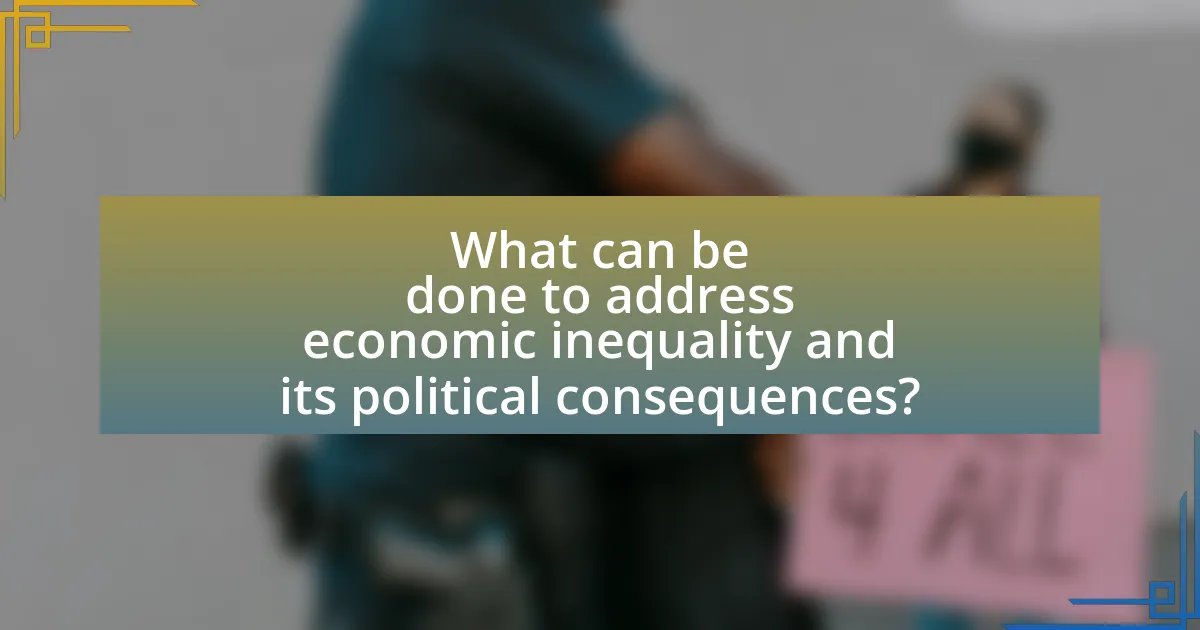
What can be done to address economic inequality and its political consequences?
To address economic inequality and its political consequences, implementing progressive taxation and increasing access to quality education are essential strategies. Progressive taxation can redistribute wealth more equitably, as evidenced by countries like Sweden, where higher tax rates on the wealthy have contributed to lower income inequality and greater social cohesion. Additionally, enhancing access to quality education can empower lower-income individuals, leading to improved economic mobility; studies show that education significantly correlates with income levels, with a report from the OECD indicating that individuals with higher education earn substantially more over their lifetimes compared to those with only a high school diploma. These measures can mitigate the political instability often associated with economic disparity, as seen in various nations where economic grievances have fueled radical movements.
What policies can mitigate the effects of economic inequality?
Progressive taxation is a policy that can effectively mitigate the effects of economic inequality. By imposing higher tax rates on higher income brackets, governments can redistribute wealth more equitably, funding social programs that benefit lower-income individuals. For instance, countries like Sweden and Denmark, which implement progressive tax systems, have significantly lower levels of income inequality compared to the United States, where tax policies are less progressive. Additionally, increasing the minimum wage can enhance the earnings of low-income workers, thereby reducing the income gap. Research from the Economic Policy Institute shows that raising the federal minimum wage to $15 by 2025 could lift millions of workers out of poverty, further addressing economic disparities.
How do progressive taxation and social welfare programs impact economic disparity?
Progressive taxation and social welfare programs reduce economic disparity by redistributing wealth and providing essential services to lower-income individuals. Progressive taxation imposes higher tax rates on higher income brackets, which generates revenue that can be used to fund social welfare programs such as healthcare, education, and housing assistance. For example, countries like Sweden and Denmark, which implement progressive tax systems, have significantly lower income inequality, as evidenced by their Gini coefficients, which measure income distribution. Social welfare programs directly support those in need, improving their economic stability and opportunities, thereby narrowing the wealth gap. Research from the Organisation for Economic Co-operation and Development (OECD) indicates that effective social welfare policies can reduce poverty rates and enhance social mobility, further contributing to a more equitable economic landscape.
What role does education play in reducing economic inequality?
Education plays a crucial role in reducing economic inequality by equipping individuals with skills and knowledge that enhance their employability and earning potential. Access to quality education enables marginalized groups to break the cycle of poverty, as evidenced by studies showing that higher educational attainment correlates with increased income levels. For instance, the U.S. Bureau of Labor Statistics reports that individuals with a bachelor’s degree earn, on average, significantly more than those with only a high school diploma, illustrating the economic benefits of education. Furthermore, education fosters social mobility, allowing individuals from lower socioeconomic backgrounds to improve their economic status, thereby contributing to a more equitable society.
How can communities foster resilience against radicalization?
Communities can foster resilience against radicalization by promoting social cohesion and inclusivity. Initiatives such as community dialogues, educational programs, and support networks can help build trust among diverse groups, reducing feelings of alienation. Research indicates that social integration decreases the likelihood of individuals turning to radical ideologies; for instance, a study by the Institute for Strategic Dialogue found that communities with strong social ties are less susceptible to extremist recruitment. By addressing economic disparities and providing opportunities for engagement, communities can create an environment that discourages radicalization.
What community initiatives have proven effective in bridging economic divides?
Community initiatives such as microfinance programs, job training and placement services, and community development corporations have proven effective in bridging economic divides. Microfinance programs, like those implemented by Grameen Bank, provide small loans to low-income individuals, enabling them to start businesses and improve their economic status. Job training and placement services, such as those offered by Goodwill Industries, equip individuals with skills that enhance employability, leading to better job opportunities and income. Community development corporations, which focus on revitalizing neighborhoods through affordable housing and local business support, have also shown success in reducing economic disparities. These initiatives collectively contribute to economic empowerment and social mobility, thereby addressing the root causes of economic inequality.
How can dialogue and engagement reduce the appeal of radical movements?
Dialogue and engagement can reduce the appeal of radical movements by fostering understanding and addressing grievances directly. When individuals feel heard and understood through open communication, they are less likely to resort to extreme ideologies as a means of expressing dissatisfaction. Research indicates that community engagement initiatives, such as town hall meetings and facilitated discussions, can effectively bridge divides and create a sense of belonging, which diminishes the allure of radical groups. For instance, a study by the Institute for Strategic Dialogue found that communities with active dialogue programs reported lower levels of radicalization among youth, highlighting the importance of inclusive conversations in mitigating extremist sentiments.
What are practical steps individuals can take to combat economic inequality?
Individuals can combat economic inequality by advocating for policies that promote fair wages and equitable taxation. Supporting initiatives such as raising the minimum wage can directly improve the income of low-wage workers, as evidenced by studies showing that higher minimum wages reduce poverty rates. Additionally, individuals can engage in community organizing to push for progressive tax reforms that ensure wealthier individuals contribute a fair share, which can help fund social programs aimed at reducing inequality. Volunteering for or donating to organizations focused on economic justice can also amplify efforts to address systemic disparities.



